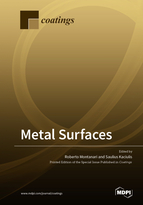Metal Surfaces
A special issue of Coatings (ISSN 2079-6412).
Deadline for manuscript submissions: closed (31 October 2020) | Viewed by 30812
Special Issue Editors
Interests: surface treatments, coatings, mechanical properties, XPS, AES, LDH
Special Issues, Collections and Topics in MDPI journals
Interests: nanotechnology; nanomaterials; 2D materials; surface physics and chemistry; surface analysis techniques (XPS, AES, UPS); photoelectron microscopy (chemical imaging)
Special Issue Information
Dear Colleagues,
Surface phenomena have a great relevance for numerous industrial processes and products. In the last few years, the surface structure and chemistry and the surface phenomena, such as segregation, oxidation, surface defects, etc., occurring in metals has attracted the increasing attention of many investigators, and quite a bit of scientific work has been devoted to this matter. The results of these investigations have contributed to deepen basic knowledge, improve industrial products, and develop new industrial applications. Moreover, in addition to the more conventional characterization techniques, novel surface-sensitive techniques, such as X-ray photoelectron spectroscopy, Auger electron spectroscopy, and electron energy loss spectroscopy, have been developed.
This Special Issue of Coatings focuses on the surface of metals and aims to bring together different research in the areas of physics, chemistry, materials science, and engineering. The scope is to highlight the state-of-art and latest achievements.
Topics of interest include, but are not limited to, the following:
- Surface phenomena;
- Surface morphology and structure;
- Surface modifications and treatments;
- Thin coatings;
- Surface-sensitive techniques;
- Physical phenomena at the surface.
Prof. Dr. Roberto Montanari
Prof. Dr. Saulius Kaciulis
Guest Editors
Manuscript Submission Information
Manuscripts should be submitted online at www.mdpi.com by registering and logging in to this website. Once you are registered, click here to go to the submission form. Manuscripts can be submitted until the deadline. All submissions that pass pre-check are peer-reviewed. Accepted papers will be published continuously in the journal (as soon as accepted) and will be listed together on the special issue website. Research articles, review articles as well as short communications are invited. For planned papers, a title and short abstract (about 100 words) can be sent to the Editorial Office for announcement on this website.
Submitted manuscripts should not have been published previously, nor be under consideration for publication elsewhere (except conference proceedings papers). All manuscripts are thoroughly refereed through a single-blind peer-review process. A guide for authors and other relevant information for submission of manuscripts is available on the Instructions for Authors page. Coatings is an international peer-reviewed open access monthly journal published by MDPI.
Please visit the Instructions for Authors page before submitting a manuscript. The Article Processing Charge (APC) for publication in this open access journal is 2600 CHF (Swiss Francs). Submitted papers should be well formatted and use good English. Authors may use MDPI's English editing service prior to publication or during author revisions.







